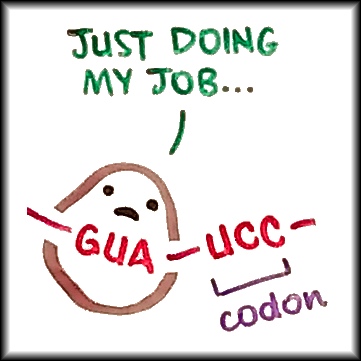
Brain BREAK! presents: Transcription and Translation.
When two words sound similar, it can be difficult to remember which is which. But these processes need not be difficult! To start off, let’s solidify two basic statements:
- Transcription happens in the nucleus.
- Translation happens in the cytoplasm.
Furthermore:
- Transcription involves DNA and mRNA.
- Translation involes mRNA, rRNA, and tRNA.
- Note that mRNA is the go-between.
Let’s start with transcription. Via a chemical signal, DNA is unzipped by an enzyme (along with others!) to reveal one gene the body needs. Recall that one gene = one protein constructed. And one gene = many G’s, C’s, A’s, and T’s (nucleic acids). Whereas DNA is that double-stranded helix we all know and love, mRNA is just one strand. It pulls up to the open DNA like a drive-thru, picking up nucleic acids that float around in the nucleus and stringing them together to complement. If the DNA code includes a G, the mRNA matches with a C. Imagine that you and I sit down at a table with an apple and an orange. If I take the apple, there’s really only one option for you. That is one way to think of Cs only matching with Gs.
From there, the mRNA squeezes out of the nucleus and looks for its siblings.
Translation follows, and this occurs in the cytoplasm. The cytoplasm refers to everything in the cell that’s not the nucleus, by the way, including the endoplasmic reticulum. In this endoplasmic maze, ribosomes – a.k.a. rRNA – and tRNA wait. “Fresh from the nucleus!” announces an mRNA, as it threads itself into a ribosome. “Aiee! That tickles!”
“Just doing my job,” the rRNA replies. Indeed, the ribosome acts as a kind of scanner. It chomps down on one codon (three bases) at a time and waits for a match. Multiple tRNA molecules float around nearby.
Each tRNA carries one amino acid, sort of on its “head.” It is made up of nucleic acids, too, with a codon featured prominently on a docking site. The loop docks with the ribosome’s codons that it complements (GUA and CAU, for instance) and they have a little hug.
At this hug, the amino acid pops off of the tRNA. “Here’s the valine you wanted!” the tRNA says. Indeed, the ribosome now squeals, “Aiee! That tickles.” All this interaction has got to be handsy, after all.
This occurs again and again, with each of mRNA’s codons being matched with a complementary tRNA inside rRNA, and each amino acid building one part of a long strand. When the mRNA has displayed all of its code to the rRNA, the strand of amino acids pop off – it’s now long enough to be a protein and do a hard day’s work!
mRNA transcribes a copy of DNA’s code. tRNA and rRNA translate the code into a protein.
♪ Jenny, I’ve got your codon… ♫ -CNx
